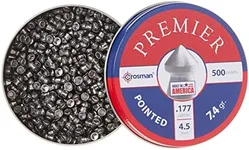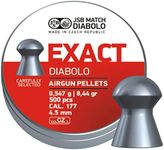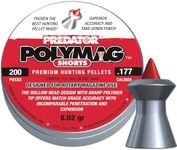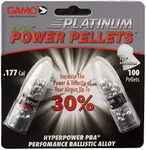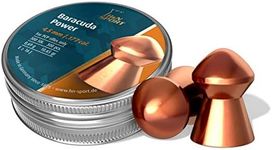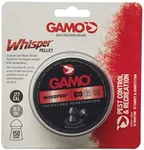Buying Guide for the Best 177 Cal Pellets
Choosing the right .177 caliber pellets is important for getting the best performance from your airgun, whether you’re target shooting, plinking, or hunting small pests. The right pellet can make a big difference in accuracy, power, and consistency. To pick the best fit, you need to understand the key specifications and how they relate to your intended use.Pellet ShapePellet shape refers to the design of the pellet’s head and body, and it greatly affects how the pellet flies and what it’s best used for. The main shapes are wadcutter (flat head), domed (rounded head), pointed, and hollow point. Wadcutter pellets are best for target shooting because they cut clean holes in paper. Domed pellets are good for general use and offer a balance of accuracy and range. Pointed pellets are designed for better penetration, making them suitable for pest control. Hollow point pellets expand on impact and are also used for hunting small pests. Choose the shape based on whether you want accuracy for targets, range, or stopping power for pests.
Pellet WeightPellet weight is measured in grains and affects both the speed and impact of the pellet. Lighter pellets (around 6-7 grains) travel faster and are good for target shooting at short distances. Medium-weight pellets (7-9 grains) offer a balance of speed and impact, making them versatile for both target shooting and light pest control. Heavier pellets (9+ grains) are slower but deliver more energy, which is better for hunting or shooting at longer distances. Match the weight to your airgun’s power and your intended use: lighter for speed and accuracy, heavier for impact and range.
Pellet MaterialMost .177 pellets are made from lead, but there are also lead-free options made from alloys or other materials. Lead pellets are traditional and generally provide good accuracy and consistency. Lead-free pellets are lighter and may be required in areas with environmental restrictions. If you’re shooting indoors or in areas where lead is a concern, consider lead-free pellets. Otherwise, lead pellets are usually the standard choice for most uses.
Pellet Skirt DesignThe skirt is the hollow base of the pellet, and its design affects how well the pellet seals in the barrel and how it stabilizes in flight. A well-designed skirt helps the pellet grip the rifling in the barrel, improving accuracy. Some skirts are thin and flare out easily, which is good for lower-powered airguns, while thicker skirts are better for high-powered airguns. If you have a lower-powered airgun, look for pellets with a softer, thinner skirt. For higher-powered airguns, a thicker skirt can handle the extra pressure without deforming.
Consistency and QualityConsistency refers to how uniform the pellets are in size, weight, and shape. High-quality pellets are made with tighter tolerances, which means each pellet is nearly identical to the next. This leads to better accuracy and reliability. Lower-quality pellets may have imperfections that can cause flyers or inconsistent shots. If accuracy is important to you, especially for target shooting or competition, look for pellets known for their consistency and quality.
